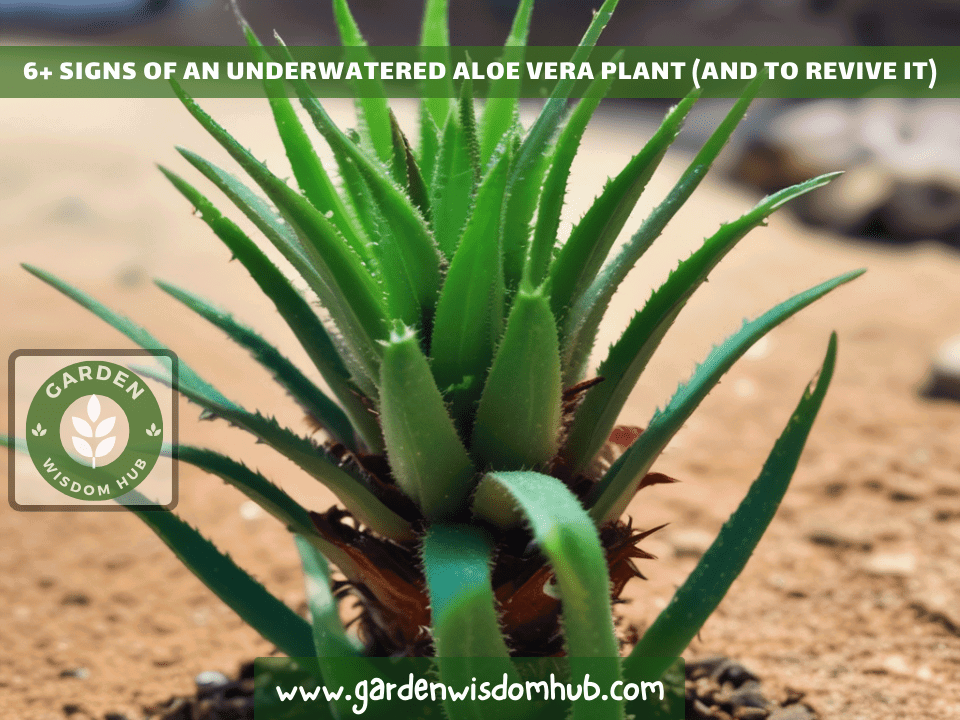
Introduction:
The aloe vera plant represents natural health due to its many uses and medical properties. However, like any living thing, it needs care to thrive. It’s funny how some people overwater their aloe vera plants. Unfortunately, this can damage their beautiful appearance. Prepare to explore underwater aloe vera plants! This article includes all the information you need to identify and revive your submerged succulent. Let’s begin!
What are the signs of an under-watered aloe Vera plant?
Following are the signs of a watered Aloe Vera Plant:
- Leaves that are as yellow as a banana peel
- Leaves that are feeling a bit down and droopy
- Edges or tips of the leaves that have taken on a brown hue
- Potting soil that’s as dry as the Sahara desert
- A plant with wrinkles that would make a raisin jealous
- Spots on the leaves that are as brown and dry as a desert cactus
Signs of an Under watered Aloe Vera Plant: An Explanation
Here’s an explanation of the signs of an under-watered aloe Vera plant:
1. Leaves that have taken on a vibrant shade of yellow:
Has aloe vera plant gossip reached you? Without adequate water, they turn yellow-leaf-like. A fashion statement! That’s an artistic assertion! This thirsty plant might need a refreshing drink to satisfy its thirst and brighten its leaves.
2. Leaves that are feeling a little down
Here’s an unusual little indicator that your aloe vera plant might be feeling a bit parched: its leaves will start to droop or bend. Time to give that plant a drink! Well, it seems like this poor plant is feeling a bit parched and can’t quite hold itself up anymore. It’s like a wilted leaf in need of a refreshing drink!
3. Oh no, looks like the leaves are sporting some brown edges or tips!
Time for a little leaf makeover, perhaps? Watch out for those thirsty aloe vera plants! If you don’t give them enough water, they might start sporting some not-so-fashionable brown edges or tips on their leaves. Time to water those thirsty plants again! This poor plant needs more water and nutrients. Poor thing can’t win! Oh, poor thing!
4. Dry potting soil:
So, picture this: the poor aloe Vera plant is sitting there, minding its own business when suddenly, the soil beneath it starts to dry up and harden. Talk about an unpleasant split! But hey, let’s not blame the plant – maybe it’s just not getting enough water. Gotta keep that soil nice and moist for our little aloe friend! Well, this can put a damper on the plant’s hydration and overall well-being.
5. Plant’s wrinkles:
As the aloe Vera plant gets thirstier, its leaves might start to sport some wrinkles or get a little shriveled. Well, it seems like this poor plant is feeling a bit parched. It’s not getting the hydration it needs to flourish.
6. Oh, those pesky brown spots and dry leaves!
Leaves that turn brown and crunchy may indicate that your plant is thirsty. Like auditioning for a desert-themed stand-up performance! Unfortunately, this plant didn’t get a hydration reminder. It has seen better days.
Understanding these indications will help you recognize and fix under-watering in your aloe vera plant to keep it healthy.
What Does an Under-watered Aloe Vera Plant Look Like?
Watering your aloe vera plant too little can cause apparent symptoms. We’ve got lots of plant issues! Yellow leaves, drooping leaves, brown edges or tips, dry potting soil, creases, and brown spots or dry leaves. A bright collection, eh?
What Does an Under-watered Aloe Vera Plant Look Like After?
Aloe vera plants can recover from under-watering with proper care. This involves hydrating the roots and putting it in a soil that drains well.
What Do Aloe Plants Look Like When They Need Water?
However, stiff, yellowish, or brownish leaves indicate that the plant needs water. Watch for visual signals to hydrate aloe plants. Aloe leaves can become thin, shriveled, and dry without water. The plant may stop growing if the leaves curl or fold inward. Squeezing a leaf with your fingers can indicate if your aloe vera plant needs watering.
What Does Overwatered Aloe Look Like?
Overwatered aloe plants may have mushy or translucent leaves, yellow or brown leaves from the bottom, and root rot signs including a foul smell or blackened, mushy roots.
Under watered Aloe Plant:
A well-maintained aloe plant has lush green leaves, an erect stance, wet soil, a smooth and plump appearance, and no flaws or dryness.
What Does an Overwatered Aloe Plant Look Like?
If you overwater your aloe plant, you may see signs. Soft, see-through leaves might become yellow or brown, starting at the bottom of the plant. Root rot may cause an unpleasant smell or discolored, mushy roots.
How Do You Fix an Overwatered Aloe Vera Plant?
Your aloe vera plant is drowning, right? Okay, no worries! Put that poor thing out of its container, let its roots dry out, and remove any mushy, decaying roots. For its home, locate good, well-draining soil. Make sure to change your watering routine to avoid drowning it again! I promise your aloe vera will appreciate it.
Thirsty Aloe Vera Plant Signs:
Under watered aloe vera plants may act abnormally and display outward symptoms of discomfort. Look at this: the plant’s leaves may become mushy and bendy.
This hypersensitivity is a great defensive mechanism. The plant is smartly taking advantage of any chance to soak up water as it occurs. These little variations in your aloe vera plant’s behavior might reveal its moisture state and help you adjust your watering schedule. Watch out for strange plant behavior! Absolutely! Look at those thirsty aloe vera plants differently:
The Bad Effects of Under watering on Aloe Vera Growth and Development:
Watering aloe vera plants too little will stunt their growth, despite outward signs. Insufficient water can disrupt a plant’s rhythm, making it hard to extract nutrients from the soil. This unfortunate plant seems to be delayed in growing. Since its new leaves and offsets stay buried, it’s not prospering. A real underachiever.
Aloe vera plants that don’t get adequate water may also struggle with environmental changes. They become fragile, sunburn-prone divas who cannot handle temperature changes or sunlight. Hydrating your aloe vera plant boosts growth and development, making it happy and healthy.
Effects on plant physiology:
Let’s explore underwatering and its effects on plant physiology. Watering Aloe Vera Plants To Little Has Poor Results: Because of its inability to manage dehydration, an under-watered aloe vera plant acts like a drama queen. Stress causes plants to close their stomata, and gas-exchanging holes on their leaves. Closing the plant’s stomata means “No more water loss, folks!” It’s intelligent for the plant to keep every drop.
Conversely, this restriction reduces the plant’s carbon dioxide intake, which photosynthesis needs. It turns out the plant doesn’t like this material. Its development and metabolism are slow, making it less active. The plant may also elect to focus on survival rather than growth and reproduction, which could affect its health and progress.
Understanding the physiological consequences will help you appreciate the importance of watering your aloe vera plant to keep it healthy and thriving.
Conclusion :
In a nutshell, knowing each plant’s needs is crucial when gardening. This applies to aloe Vera. Guess what? A quick dip in the water can save an aloe Vera plant! A keen eye and a few tricks will do. If you give an aloe Vera plant the right nutrients and well-draining soil, it will thrive and provide you with its amazing nutritional and cosmetic benefits for life.
FAQs:
How Can I Tell if My Aloe Vera Plant Needs Water?
A well-hydrated leaf is plump and wet. Water is needed when a leaf is stiff, yellow, or brown.
How Do I Know if My Aloe Vera Needs Water?
Pay attention to your aloe vera plant’s leaves to see whether or not it needs hydration. Plump, succulent leaves suggest enough watering.
To learn more about Houseplants check out my guides:
Spider Plant Growth Stages Life Cycle & Care Guide
Spider Plant Care Propagation Tips & Tricks for a Bushier Plant
6 Types of Spider Plants Exploring the most common top varieties
Tips to Save a Dying Corn Plant: A Step-by-Step Complete Guide
Aloe Plant Overwatered: Signs and Step-by-Step Solutions
How to Revive and Save an Aloe Plant: A Complete Guide
Plants That Look Like Aloe Vera
How to Care for Majesty Palm: Essential Tips for Healthy Growth
Ultimate Guide To Growing Herbs Indoors With Grow Light In Pots
A Complete Guide On Starting Your Very Own Indoor Herb Garden
The Ultimate Guide to Bird of Paradise Care and Growing
James Porter
Welcome to our haven of gardening and plant care, where outdoor and indoor planting enthusiasts come together! At Gardening Wisdom Hub, we aim to provide you with the most authentic information on anything related to gardening, plant care, seasonal planting etc.
The author of our website is James Porter, an experienced industry veteran. He has a deep interest in everything green. James’s enthusiasm for exploring plants’ features and learning new gardening methods began at a young age. Gradually, his passion increased with time, leading him to become a highly esteemed professional. His extensive knowledge makes him a priceless resource for inexperienced and seasoned gardeners.

